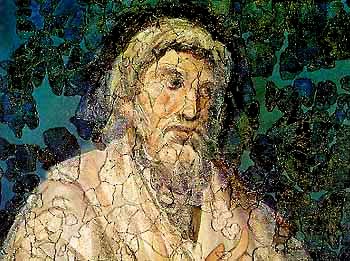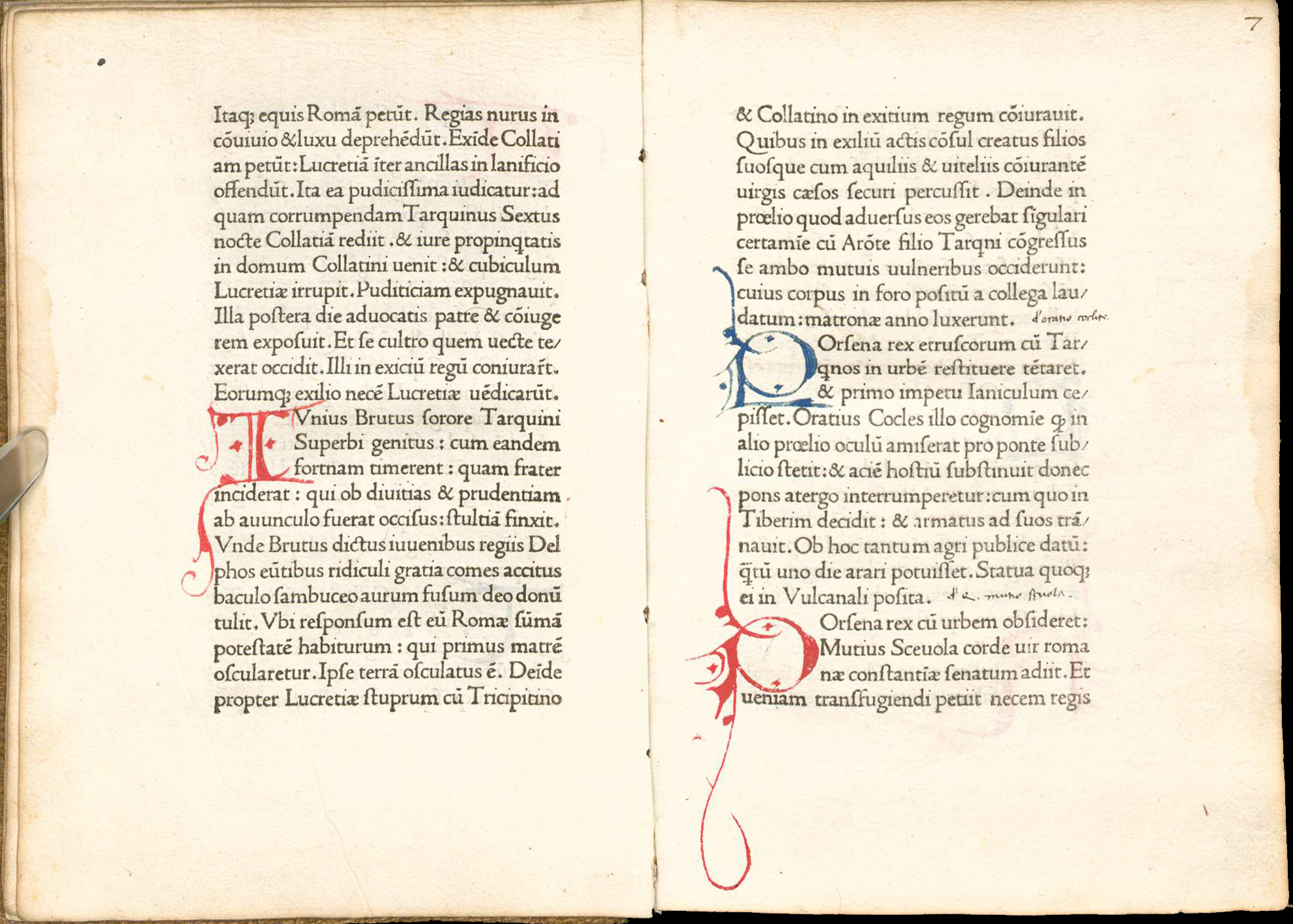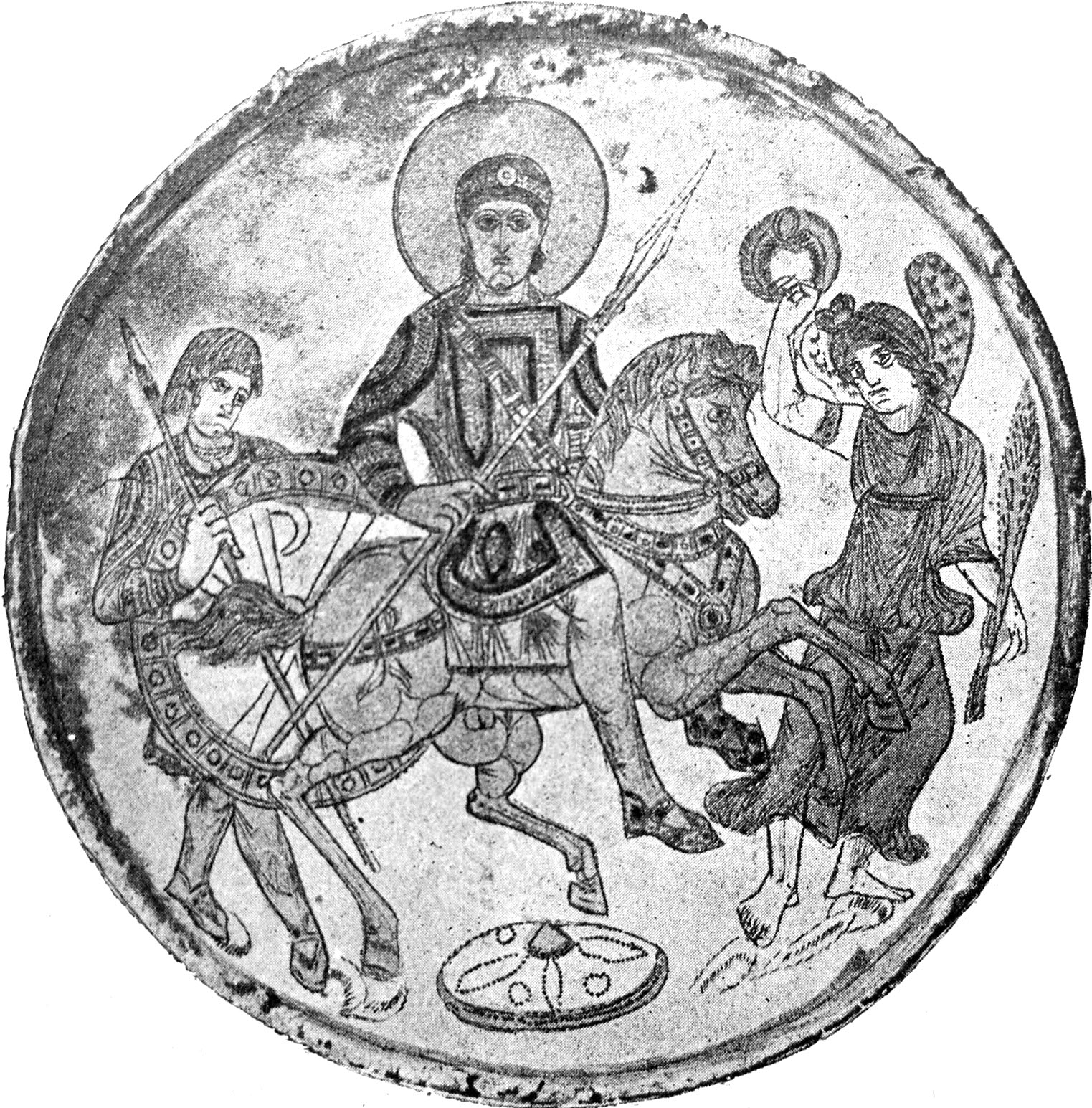|
De Mortibus Persecutorum
(''On the Deaths of the Persecutors'') is a hybrid historical and Christian apologetical work by the Roman philosopher Lactantius, written in Latin sometime after AD 316. Contents After the monumental Institutiones Divinae, Divine Institutes, the comparatively brief ''De mortibus persecutorum'' is probably the most important extant work of Lactantius, a convert to Christianity who served at the courts of both the pagan Diocletian and the Christian Constantine the Great. In this work, Lactantius describes in occasionally lurid detail the downfall and deaths of the most egregious persecutors of Christians. The first few chapters briefly cover the ends of the earliest Christian persecutors: Nero, Domitian, Decius, Valerian (emperor), Valerian, and Aurelian. The bulk of the work, however, concerns the deeds and deaths of the Tetrarchy: Diocletian, Maximian, Galerius, Constantius Chlorus, Constantius, Maximinus Daza, Maximinus, Constantine the Great, Constantine and Maxentius. It is o ... [...More Info...] [...Related Items...] OR: [Wikipedia] [Google] [Baidu] |
Lactantius
Lucius Caecilius Firmianus Lactantius (c. 250 – c. 325) was an early Christian author who became an advisor to Roman emperor, Constantine I, guiding his Christian religious policy in its initial stages of emergence, and a tutor to his son Crispus. His most important work is the ''Institutiones Divinae'' ("The Divine Institutes"), an apologetic treatise intended to establish the reasonableness and truth of Christianity to pagan critics. He is best known for his apologetic works, widely read during the Renaissance by humanists, who called Lactantius the "Christian Cicero". Also often attributed to Lactantius is the poem '' The Phoenix'', which is based on the myth of the phoenix from Egypt and Arabia. Though the poem is not clearly Christian in its motifs, modern scholars have found some literary evidence in the text to suggest the author had a Christian interpretation of the eastern myth as a symbol of resurrection. Biography Lactantius was of Punic or Berber origin, born in ... [...More Info...] [...Related Items...] OR: [Wikipedia] [Google] [Baidu] |
Galeria Valeria
Galeria Valeria (died 315) was the daughter of Roman Emperor Diocletian and wife of his co-emperor Galerius. Biography Born as Valeria to Diocletian and Prisca, she married Galerius in 293, when her father elevated him to the position of Caesar. This marriage was clearly organized to strengthen the bonds between the two emperors. Valeria was raised to the title of Augusta and ''Mater Castrorum'' in November 308. Since Galerius fathered no child with her, Valeria adopted her husband's illegitimate son, Candidianus, as her own. In her honor, Galerius renamed the province of Upper Pannonia ''Valeria'', which he had improved by draining marshes and removing forests. When Galerius died, in 311, Licinius was entrusted with the care of Valeria and her mother Prisca. The two women, however, fled from Licinius to Maximinus Daia, whose daughter was betrothed to Candidianus. After a short time, Valeria refused the marriage proposal of Maximinus, who arrested and confined her in Syria a ... [...More Info...] [...Related Items...] OR: [Wikipedia] [Google] [Baidu] |
Moissac
Moissac () is a commune in the Tarn-et-Garonne department in the Occitanie region in southern France. The town is situated at the confluence of the rivers Garonne and Tarn at the Canal de Garonne. Route nationale N113 was constructed through the town and between Valence-d'Agen and Castelsarrasin. It is served by Moissac station on the Bordeaux-Toulouse line. History Initially Moissac was part of the department of Lot. In 1808, Napoleon decreed the city be attached to the new department of Tarn-et-Garonne. It was the chief town of the district from 1800 to 1926. Moissac was heavily damaged in March 1930 by flooding of the Tarn, which devastated much of southwestern France. It was counted as a 100-year flood. One hundred twenty people were reported to have died in the city. In 2020, National Rally politician Romain Lopez was elected mayor. Moissac Abbey Moissac is known internationally for the artistic heritage preserved in the medieval Moissac Abbey. This church is a site on ... [...More Info...] [...Related Items...] OR: [Wikipedia] [Google] [Baidu] |
De Viris Illustribus
''De Viris Illustribus'', meaning "concerning illustrious men", represents a genre of literature which evolved during the Italian Renaissance in imitation of the exemplary literature of Ancient Rome. It inspired the widespread commissioning of groups of matching portraits of famous men from history (''Uomini Famosi'') to serve as moral role models. With its inception in the circle of Cicero, various ancient works bear the titles ''De Viris Illustribus'' or ''De hominibus illustribus'', including: * Cornelius Nepos' ''De Viris Illustribus'', from which Aulus Gellius draws an anecdote of Cato the Elder; Cornelius Nepos also produced a ''Liber De Excellentibus Ducibus Gentium'' (Lives of Eminent Commanders). * Suetonius' fragmentary ''Lives'' include grammarians, rhetoricians, historians, and poets. * An anonymous ''De Viris Illustribus'' probably dating to the first half of the 4th century is a compilation of 86 brief biographies of individuals important to Roman history, from ... [...More Info...] [...Related Items...] OR: [Wikipedia] [Google] [Baidu] |
Saint Jerome
Jerome (; la, Eusebius Sophronius Hieronymus; grc-gre, Εὐσέβιος Σωφρόνιος Ἱερώνυμος; – 30 September 420), also known as Jerome of Stridon, was a Christian priest, confessor, theologian, and historian; he is commonly known as Saint Jerome. Jerome was born at Stridon, a village near Emona on the border of Dalmatia and Pannonia. He is best known for his translation of the Bible into Latin (the translation that became known as the Vulgate) and his commentaries on the whole Bible. Jerome attempted to create a translation of the Old Testament based on a Hebrew version, rather than the Septuagint, as Latin Bible translations used to be performed before him. His list of writings is extensive, and beside his biblical works, he wrote polemical and historical essays, always from a theologian's perspective. Jerome was known for his teachings on Christian moral life, especially to those living in cosmopolitan centers such as Rome. In many cases, he focu ... [...More Info...] [...Related Items...] OR: [Wikipedia] [Google] [Baidu] |
Edict Of Milan
The Edict of Milan ( la, Edictum Mediolanense; el, Διάταγμα τῶν Μεδιολάνων, ''Diatagma tōn Mediolanōn'') was the February 313 AD agreement to treat Christians benevolently within the Roman Empire. Frend, W. H. C. (1965). ''The Early Church''. SPCK, p. 137. Western Roman Emperor Constantine I and Emperor Licinius, who controlled the Balkans, met in Mediolanum (modern-day Milan) and, among other things, agreed to change policies towards Christians following the edict of toleration issued by Emperor Galerius two years earlier in Serdica. The Edict of Milan gave Christianity legal status and a reprieve from persecution but did not make it the state church of the Roman Empire. That occurred in AD 380 with the Edict of Thessalonica. The document is found in Lactantius's '' De mortibus persecutorum'' and in Eusebius of Caesarea's ''History of the Church'' with marked divergences between the two.Cross and Livingstone. ''The Oxford Dictionary of the Chri ... [...More Info...] [...Related Items...] OR: [Wikipedia] [Google] [Baidu] |
Chi-rho
The Chi Rho (☧, English pronunciation ; also known as ''chrismon'') is one of the earliest forms of Christogram, formed by superimposing the first two (capital) letters—chi (letter), chi and rho (ΧΡ)—of the Greek word (Christ (title), Christos) in such a way that the vertical stroke of the rho intersects the center of the chi. The Chi-Rho symbol was used by the Roman Emperors, Roman Emperor Constantine I (emperor), Constantine I (r. 306–337 AD) as part of a military standard (vexillum). Constantine's standard was known as the Labarum. Early symbols similar to the Chi Rho were the Staurogram () and the IX monogram (). In pre-Christian times, the Chi-Rho symbol was also used to mark a particularly valuable or relevant passage in the margin of a page, abbreviating ''chrēston'' (good). Some coins of Ptolemy III Euergetes (r. 246–222 BC) were marked with a Chi-Rho. Although formed of Greek characters, the device (or its separate parts) is frequently found serving as ... [...More Info...] [...Related Items...] OR: [Wikipedia] [Google] [Baidu] |
In Hoc Signo Vinces
"''In hoc signo vinces''" (, ) is a Latin phrase conventionally translated into English as "In this sign thou shalt conquer". The Latin phrase itself renders, rather loosely, the Greek phrase "", transliterated as "''en toútōi níka''" (, ), literally meaning "in this, conquer". History Lucius Caecilius Firmianus Lactantius was an early Christian author (c. 240 – c. 320) who became an advisor to the first Christian Roman emperor, Constantine I (and tutor to his son), guiding the Emperor's religious policy as it developed during his reign. His work ''De Mortibus Persecutorum'' has an apologetic character, but has been treated as a work of history by Christian writers. Here Lactantius preserves the story of Constantine's vision of the Chi Rho before his conversion to Christianity. The full text is found in only one manuscript, which bears the title, ''Lucii Caecilii liber ad Donatum Confessorem de Mortibus Persecutorum''. The bishop Eusebius of Caesaria, a historian, st ... [...More Info...] [...Related Items...] OR: [Wikipedia] [Google] [Baidu] |
Eusebius Pamphilus
Eusebius of Caesarea (; grc-gre, Εὐσέβιος ; 260/265 – 30 May 339), also known as Eusebius Pamphilus (from the grc-gre, Εὐσέβιος τοῦ Παμφίλου), was a Greek historian of Christianity, exegete, and Christian polemicist. In about AD 314 he became the bishop of Caesarea Maritima in the Roman province of Syria Palaestina. Together with Pamphilus, he was a scholar of the biblical canon and is regarded as one of the most learned Christians during late antiquity. He wrote ''Demonstrations of the Gospel'', '' Preparations for the Gospel'' and ''On Discrepancies between the Gospels'', studies of the biblical text. As "Father of Church History" (not to be confused with the title of Church Father), he produced the ''Ecclesiastical History'', ''On the Life of Pamphilus'', the ''Chronicle'' and ''On the Martyrs''. He also produced a biographical work on Constantine the Great, the first Christian Roman emperor, who was ''augustus'' between AD 306 and AD ... [...More Info...] [...Related Items...] OR: [Wikipedia] [Google] [Baidu] |
Theophany
Theophany (from Ancient Greek , meaning "appearance of a deity") is a personal encounter with a deity, that is an event where the manifestation of a deity occurs in an observable way. Specifically, it "refers to the temporal and spatial manifestation of God in some tangible form." Where the deity does not take tangible form (outward manifestation), the broader term used for inward manifestation is divine revelation or divine inspiration. Where the spirit of god is manifest in a person the term used is divine incarnation, avatar or personification of the deity. Traditionally the term "theophany" was used to refer to appearances of the gods in ancient Greek and in Near Eastern religions. While the ''Iliad'' is the earliest source for descriptions of theophanies in classical antiquity (which occur throughout Greek mythology), probably the earliest description appears in the Epic of Gilgamesh. In the specific usage for Christians and Jews, with respect to the Bible, ''theophany'' r ... [...More Info...] [...Related Items...] OR: [Wikipedia] [Google] [Baidu] |
Battle Of The Milvian Bridge
The Battle of the Milvian Bridge took place between the Roman Emperors Constantine I and Maxentius on 28 October 312. It takes its name from the Milvian Bridge, an important route over the Tiber. Constantine won the battle and started on the path that led him to end the Tetrarchy and become the sole ruler of the Roman Empire. Maxentius drowned in the Tiber during the battle; his body was later taken from the river and decapitated, and his head was paraded through the streets of Rome on the day following the battle before being taken to Africa. According to Christian chroniclers Eusebius of Caesarea and Lactantius, the battle marked the beginning of Constantine's conversion to Christianity. Eusebius of Caesarea recounts that Constantine and his soldiers had a vision sent by the Christian God. This was interpreted as a promise of victory if the sign of the Chi Rho, the first two letters of Christ's name in Greek, was painted on the soldiers' shields. The Arch of Constantine, er ... [...More Info...] [...Related Items...] OR: [Wikipedia] [Google] [Baidu] |
Flavius Severianus
Flavius Severianus (died 313) was the son of the Roman Emperor Flavius Valerius Severus. Life and execution After his father died in 307 in Italy having surrendered to his rivals Maximian and Maxentius, Severus' young son Flavius Severianus sought refuge in the Eastern part of the empire under Galerius. When Galerius died in 311, Severianus suspected that Licinius intended to do him harm as a potential rival in his ambitions to rule the East and so he fled to Maximinus Daza in Asia who made him ''praeses'' (governor) of the province of Isauria. In August 313 Maximinus Daza went to war against Licinius. Severianus accompanied him on this campaign which ended in defeat for Daza. Severianus was captured following the death of Daza, and Licinius had him executed under the pretense that Severianus intended to assume the imperial office himself. [...More Info...] [...Related Items...] OR: [Wikipedia] [Google] [Baidu] |





